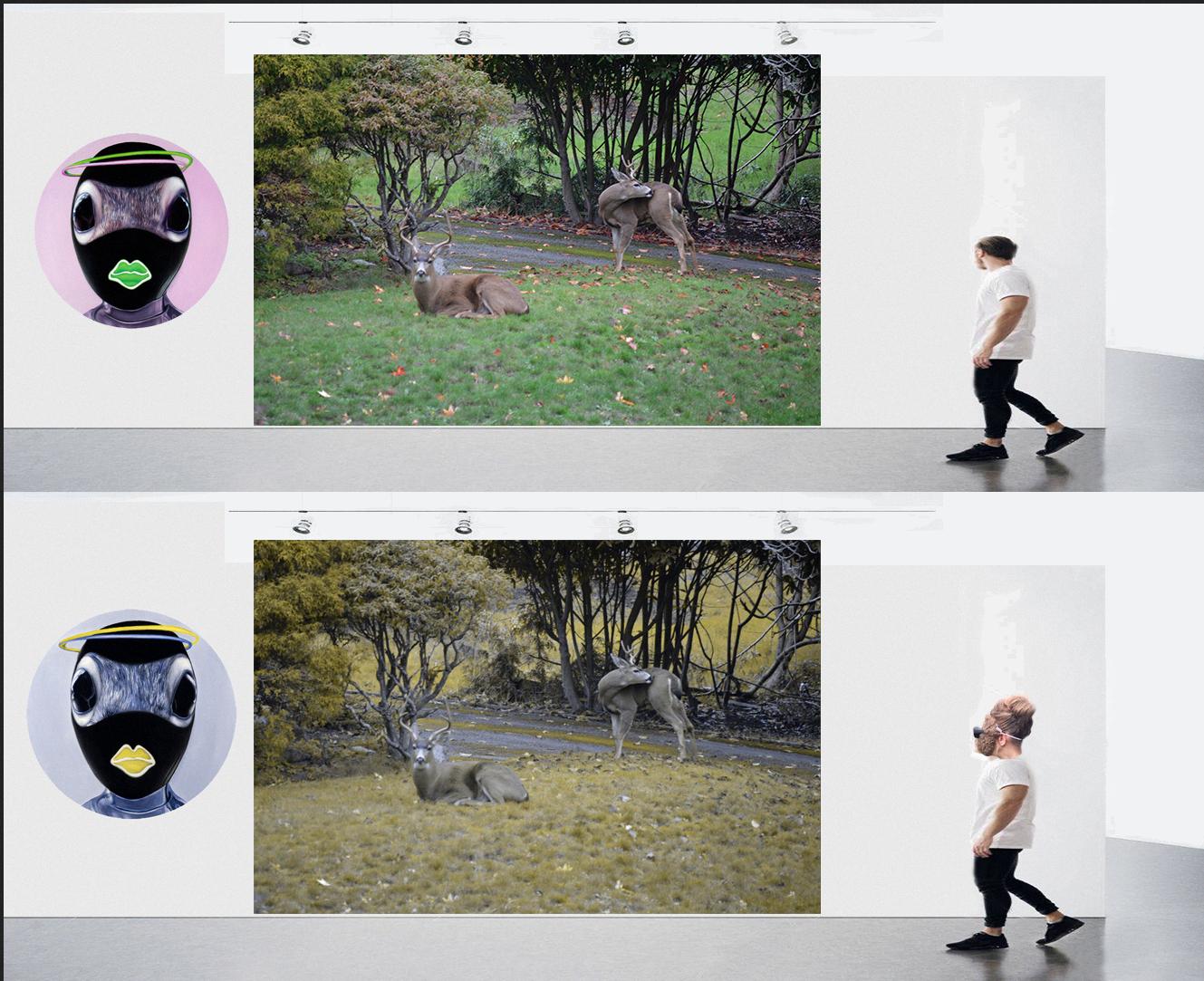Dichromatic vision is a color vision deficiency affecting about 2% of the human population. People with dichromatic vision are unable to distinguish certain colors, as they only have two of the three types of retinal cone photoreceptors functioning properly. This means that they can only see a limited number of colors, and instead of seeing the full range of colors in a rainbow, white is evoked by monochromatic light.
To understand what dichromatic vision is, it’s important to know that humans typically have trichromatic color vision. Trichromats can distinguish three primary colors – red, green, and blue – as well as their mixtures (yellow, cyan and magenta). Those with dichromatic vision usually lack one of these three primary colors, meaning they are unable to see all the other hues that combine to make up the full spectrum.
This type of color deficiency can be caused by a variety of factors, such as genetic inheritance or medical conditions like diabetes or macular degeneration. It occurs more frequently in males than in females due to its association with X-linked genes. Dichromacy can also be acquired after an illness or an accident has damaged the eyesight.
For those living with dichromatic vision, everyday activities like reading and driving may bcome difficult and challenging as certain colors might appear blurry or indistinguishable from one another. Special sunglasses that block out certain wavelengths can help reduce glare and improve contrast sensitivity for people with this condition. Additionally, there are apps available for smartphones that allow users to customize their display according to their individual needs and preferences.
Living with dichromatic vision may have some limitations but it doesn’t necessarily mean you have to miss out on life’s visual pleasures; many people manage just fine by learning how to use strategies like avoiding bright lights and wearing protective eyewear when necessary. There are also support groups available where people can talk about their experiences and share tips on how to make everyday life more comfortable and enjoyable despite this condition.
What Colors Can Dichromats Distinguish?
Dichromats have a reduced ability to distinguish colors, so they typically see a more limited range of hues than trichromats. They will generally see fewer hues in the rainbow and may not be able to distinguish between certain colors. For example, dichromats may see red and green as the same color, or they may not be able to differentiate between yellow and blue. Some dichromats may also see white when they experience both cone cells being equally excited.

Are People with Dichromacy Color Blind?
No, dichromats are not color blind. Although they only have two types of cone photoreceptors functioning, they still can perceive some level of color. Dichromats can usually distinguish between red and green and sometimes yellow, but typically cannot distinguish between blue and yellow or between green and purple. Because of this limitation, dichromats usually have difficulty distinguishing certain shades of colors from one another.
Do Humans Have Dichromatic Vision?
No, humans do not have dichromatic vision. Most humans have trichromatic color vision, meaning they can distinguish between three different colors: red, green, and blue. This is known as the ‘red-green-blue’ (or RGB) color system. A small percentage of humans have dichromatic color vision, meaning they can only distinguish between two different colors; usually red and green. This type of vision is typically caused by a genetic condition known as anomalous trichromacy.
What is Dichromacy?
Dichromacy is a deficiency of color vision in which the person can only distinguish between two out of the three primary colors. This means that those with dichromacy are unable to perceive certain hues and shades, and may have difficulty distinguishing between similar colors. The most common form of dichromacy is red-green color blindness, although other forms exist. Dichromacy affects approximately 1 in 12 men and 1 in 200 women.
The Importance of Dichromatic Vision
Dichromatic vision is important because it povides a wide range of advantages to animals that possess it. These advantages include enhanced color detection, improved motion detection, increased night vision capabilities, and the ability to detect camouflaged objects. Color detection is important for a variety of reasons, such as finding food or recognizing mates. Motion detection allows animals to detect predators or prey more quickly. Night vision can help animals survive in low-light environments, and the ability to detect camouflaged objects helps them avoid potential threats. In short, dichromatic vision helps animals survive in their environment by giving them an edge in detecting and avoiding danger.

Source: carollyne.com
The Perception of Red by a Colorblind Person
To a person with color blindness, red may look like a much darker shade of green. This is because the eye lacks the ability to differentiate between certain colors. The exact shade of color can vary from person to person, and can also depend on the type of color blindness that the individual has. For example, some people with red-green color blindness will see red as a very dark brown or black color, while others may see it as a dark yellow or orange.
Causes of Dichromatism
Dichromatism is an inherited condition caused by a genetic mutation of the genes responsible for producing light-sensitive pigments in the retina. Specifically, it is caused by a rearrangement of the L/M genes, which are responsible for the production of the two types of photopigment present in human eyes: long-wavelength (L) and medium-wavelength (M). This rearrangement results either in the deletion of all but one L or M pigment gene, or in the production of a gene array in which the firt two genes encode a pigment of the same spectral class (i.e., L/L or M/M). As a result, individuals with this condition have only one type of cone pigment, leading to reduced color vision and dichromatism.
Types of Colorblindness
The four main types of colorblindness are deuteranomaly, protanomaly, protanopia, and deuteranopia. Deuteranomaly is the most common type of colorblindness and is a red-green deficiency in which greens appear more red. Protanomaly is another red-green deficiency in which red appears more green and less bright. Protanopia and deuteranopia, on the other hand, make it impossible for an individual to tell the difference between red and green at all. It is important to note that there are other types of colorblindness beyond these four main categories, such as tritanomaly and tritanopia.
The Meaning of Dichromatic Eyes
Dichromatic eyes are eyes that have only two types of color receptors. People with dichromatic eyes have difficulty distinguishing certain colors and can only see a limited range of hues. This is sometimes referred to as “color-blindness” or “color vision deficiency”. Because there are three types of color receptors, people with dichromatic eyes are not completely color-blind, but they may need to rely more on brightness and contrast to distinguish colors.

What Percentage of People Have Dichromatic Eyes?
Dichromatic eyes, or complete heterochromia, are even less common than partial heterochromia, occurring in an estimated 0.1 percent of the population. This means that only one in every 1,000 people have eyes of two different colors. Complete heterochromia can be further divided into two groups: sectoral and central. In sectoral heterochromia, the color change occurs only within a certain area of the iris, while in central heterochromia, the color change occurs in the center of the eye.
What Does Tetrachromatic Vision Look Like?
Tetrachromacy is a rare genetic condition that affects approximately 12% of women and less than 1% of men. This condition gives people the ability to see up to 100 million diffrent shades of color, which is significantly more than the average human being who can only perceive around 1 million different shades. As a result, tetrachromats are able to see colors that most people cannot, including subtle shades and hues that the average person can not even imagine.
For example, when looking at a rainbow someone with normal vision may see seven distinct colors (red, orange, yellow, green, blue, indigo and violet). However, someone with tetrachromatic vision may be able to distinguish hundreds of different hues within each color. A tetrachromat might be able to identify variations in shade between light crimson and deep scarlet or between sky blue and navy blue. In addition to seeing more intense and vivid colors than those with regular vision, they also have much better color discrimination skills. This means they are capable of distinguishing between two very similar shades that would appear identical to someone with normal vision.
This unique vision also gives them the ability to detect patterns in their environment that others may not be able to recognize. For instance, they might be able to notice small details such as petals on a flower or blades of grass blowing in the wind that would normally go unnoticed by those without tetrachromatic vision.
Overall, having tetrachromatic vision is like experiencing life through an artist’s eye; it allows you to appreciate the beauty in everyday objects that many people don’t even realize exist– an ability that truly makes you one-of-a-kind!
What is Dichromatic Vision?
Dichromatic vision is a form of colour blindness where an individual is unable to distinguish between certain colours, typically red and green. It is caused by the absence of one type of cone photoreceptor in the retina, which results in a decreased ability to perceive colour hues. Dichromats typically have eiher protanopia (absence of red cones) or deuteranopia (absence of green cones), although some people are trichromats and may be unable to differentiate between all three primary colours. Although dichromatic vision can cause difficulties with everyday tasks such as identifying traffic signals, many individuals are able to compensate for their condition with special lenses or other visual aids.
Are Humans Dichromatic or Trichromatic?
Humans are trichromatic, meaning we have thre distinct classes of photoreceptors in our eyes. These photoreceptors are sensitive to different wavelengths of light and allow us to see a range of colors. The three types of photoreceptors are called cones and they are sensitive to long (L), medium (M), or short (S) wavelengths of light. When we look at an object, the cones in our eyes absorb the different wavelengths of light reflected off the object, allowing us to perceive its color. Our brains then combine the signals from each cone type in order to create a full-color image. This trichromatic system allows us to distinguish between more than just black and white, and helps us recognize a variety of colors in our environment.
Types of Dichromatism
Dichromatism is a condition that affects an individual’s ability to see colors, resulting in them being able to only perceive two of the three primary colors. The three types of Dichromatism are tritanopia, deuteranopia, and protanopia.
Tritanopia is a type of Dichromatism where an individual can only perceive blue light, and cannot distinguish between green and red light. This type of Dichromatism is also known as blue-yellow color blindness.
Deuteranopia is anther type of Dichromatism where the individual can only perceive green light, and cannot distinguish between red and blue light. This condition is commonly referred to as red-green color blindness.
Protanopia is a type of Dichromatism where an individual can only perceive red light, and cannot distinguish between green and blue light. This condition is also known as total color blindness or monochromacy.
The Dichromatic Theory Explained
The Dichromatic theory is a scientific theory proposed by August Beer in 1815, which states that all color can be produced by the mixture of just two primary colors. According to this theory, each color is created when one of the two primary colors is mixed with varying amounts of white and/or black. This means that all other hues, tints, and shades are simply variations of these two basic colors. Beer used his findings to explain that certain objects apper differently when viewed under various lighting conditions or from different angles; he argued that these changes were due to an alteration in the ratio of the two primary colors present. The Dichromatic theory has been further developed over time and is now used to explain how color vision works and why some people are unable to distinguish between certain hues.

Conclusion
In conclusion, dichromatic vision is an inherited condition that affects approximately 2% of the human population. People with dichromatic vision are only able to distinguish two of the three types of retinal cone photoreceptors. This means that they can only recognize a limited number of colors and are not able to experience white in the rainbow like trichromats. Despite these limitations, people with dichromatic vision can still match any given hue using two other wavelengths of light. This demonstrates that even thouh their color perception is different from those with normal color vision, it is still possible to enjoy the beauty of our world.
